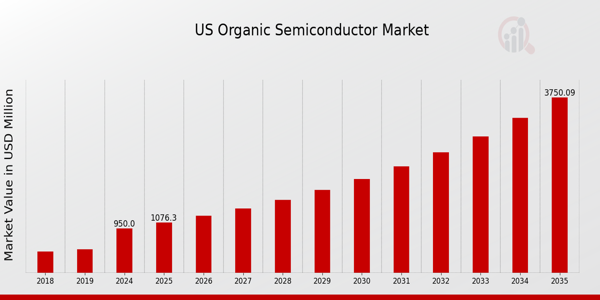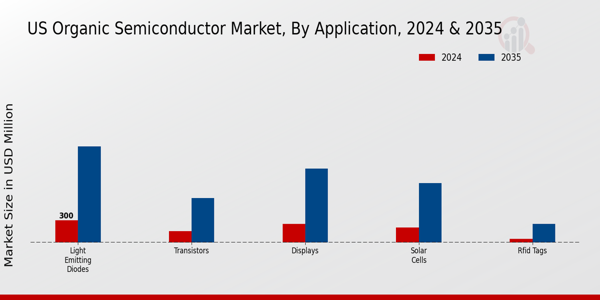US Organic Semiconductor Market Overview:
US Organic Semiconductor Market Size was estimated at 753.3 (USD Million) in 2023. The US Organic Semiconductor Market Industry is expected to grow from 950(USD Million) in 2024 to 3,750 (USD Million) by 2035. The US Organic Semiconductor Market CAGR (growth rate) is expected to be around 13.295% during the forecast period (2025 - 2035).
Key US Organic Semiconductor Market Trends Highlighted
The US Organic Semiconductor Market is experiencing significant growth due to the increasing demand for energy-efficient and flexible electronic devices. A key market driver is the rising adoption of organic semiconductors in sectors such as consumer electronics, healthcare, and automotive. The push towards sustainability and eco-friendly materials is propelling manufacturers to explore organic semiconductors as alternatives to traditional silicon-based components. Opportunities to be captured include innovations in organic light-emitting diodes (OLEDs) and organic photovoltaic cells, which are gaining traction in both consumer and commercial applications.
Recent trends show that major US tech companies are investing heavily in research and development for organic semiconductor technologies, leading to advancements that enhance performance and efficiency. Moreover, several government initiatives in the US are aimed at supporting green technology and reducing carbon footprints, which emphasizes the importance of organic materials in future semiconductor applications. The emphasis on reducing environmental impact is changing the landscape, with numerous startups emerging to focus exclusively on organic semiconductor solutions.
Overall, the landscape is evolving rapidly, driven by technological advancements and a strong focus on sustainable practices, allowing the US to remain at the forefront of organic semiconductor innovation.

Source: Primary Research, Secondary Research, MRFR Database and Analyst Review
US Organic Semiconductor Market Drivers
Growing Demand for Energy-Efficient Electronics
The US Organic Semiconductor Market Industry is experiencing accelerated growth driven by the increasing demand for energy-efficient electronic devices. According to the U.S. Department of Energy, energy consumption in electronic devices accounts for approximately 10 percent of total U.S. energy usage. This prompts manufacturers to prioritize organic semiconductors, known for their low power consumption and lightweight properties, to enhance energy efficiency in devices such as smartphones, televisions, and wearable technology.
As companies like Samsung Electronics and LG Electronics pivot towards organic light-emitting diode (OLED) technology, which heavily utilizes organic semiconductors, there's a clear push to invest in environmentally friendly alternatives that contribute to energy savings. This trend is likely to reinforce the growth trajectory of the US Organic Semiconductor Market Industry, as more consumers and industries seek sustainable solutions.
Rising Adoption of Flexible and Wearable Devices
The US Organic Semiconductor Market Industry benefits significantly from the increasing adoption of flexible and wearable devices. The shift towards such devices is heavily influenced by advancements in technology and consumer preferences for portability and convenience. According to the Consumer Technology Association, the sales of wearable devices have surged by over 25% annually in recent years, indicating a robust market potential.
Companies like Fitbit and Apple are leading the charge, developing health-monitoring devices that rely on organic semiconductor technology for their flexible displays and low power requirements.This growing trend is likely to further stimulate the market as more manufacturers integrate organic semiconductors into their products to meet consumer expectations.
Supportive Government Policies for Green Technologies
The US Organic Semiconductor Market Industry is being positively influenced by supportive government policies aimed at promoting green technologies. The Green Technologies Act introduced new tax incentives for companies that invest in sustainable and energy-efficient technologies, which include organic semiconductor production. This has encouraged a surge in Research and Development investments among US manufacturers, with a reported increase of 15% year-on-year in R&D spending for innovative materials.
Organizations like the U.S. Environmental Protection Agency have also been implementing initiatives that promote the adoption of organic semiconductors in applications that can significantly reduce environmental impact. With the government backing, the organic semiconductor sector is likely to flourish in the US, driving market growth.
Technological Advancements in Organic Semiconductor Materials
The continuous technological advancements in organic semiconductor materials are propelling the growth of the US Organic Semiconductor Market Industry. Innovative developments, such as improved stability and efficiency of organic materials, have been documented to enhance the performance of organic semiconductors by over 30% in recent years. Institutions like MIT and Stanford are leading groundbreaking research in this field, focusing on creating novel materials that exceed the efficiency of traditional silicon-based components.With patents for new organic semiconductor technologies on the rise, manufacturers in the US are increasingly adopting these advancements to improve device performance while reducing manufacturing costs.
This trend signifies a promising future for the market as improved materials drive applications in various electronic sectors.
US Organic Semiconductor Market Segment Insights:
Organic Semiconductor Market Application Insights
The US Organic Semiconductor Market in the Application segment is set to experience significant expansion, reflecting the diverse utility of organic semiconductors across various sectors. Displays, in particular, have gained traction due to the rising demand for flexible and lightweight screens that enhance user experience, pushing the boundaries of technology in consumer electronics. Solar cells utilize organic semiconductors to promote sustainable energy solutions, highlighting the shift towards renewable energy sources.
Light Emitting Diodes (LEDs) powered by organic materials are increasingly prioritized for their energy-efficient properties, aligning with environmental goals and offering longevity compared to traditional lighting.Transistors based on organic semiconductors are crucial in advancing the performance of electronic circuits, thereby facilitating the miniaturization of devices.
Furthermore, RFID tags leverage organic semiconductor technology for improved functionality in inventory management and supply chain automation, showcasing efficiency in logistics and smart tracking systems. The integration of organic semiconductors in these applications parallels market trends emphasizing sustainability and technological innovation, providing opportunities for immense growth driven by consumer demand and evolving industry standards.Each application plays a vital role in shaping the US Organic Semiconductor Market dynamics, reflecting a shift towards more efficient, versatile, and environmentally friendly solutions in the technology landscape.

Source: Primary Research, Secondary Research, MRFR Database and Analyst Review
Organic Semiconductor Market Type Insights
The US Organic Semiconductor Market has been experiencing substantial growth, driven by the increasing demand for efficient electronics and eco-friendly solutions. Within this market, various types of organic semiconductors, including Organic Photovoltaics, Organic Light Emitting Diodes, Organic Field Effect Transistors, and Organic Photodetectors, are gaining traction. Organic Photovoltaics are particularly significant for their role in sustainable energy, as they convert sunlight into electricity with the potential for low-cost production and lightweight applications, making solar technology more accessible.Organic Light Emitting Diodes are integral to display technology, offering energy-efficient lighting solutions and high-quality visuals, thus revolutionizing the television, smartphone, and lighting industries.
The importance of Organic Field Effect Transistors lies in their potential for miniaturization and flexibility, making them suitable for various electronic applications, including flexible displays and wearable technology. Organic Photodetectors are also emerging as pivotal elements in optical sensor applications, enabling advancements in mobile devices, cameras, and smart technology.The diverse applications and growth potential in these segments contribute significantly to the overall US Organic Semiconductor Market, fostering innovation and sustainable solutions in the electronics sector.
Organic Semiconductor Market Material Insights
The US Organic Semiconductor Market, particularly in the Material segment, showcases a dynamic landscape characterized by its diverse composition of Small Molecules, Polymers, and Nanomaterials. Small Molecules play a crucial role in the development of high-performance organic semiconductors, thanks to their superior charge transport properties and stability, making them essential for applications like organic light-emitting diodes (OLEDs) and organic photovoltaic devices. Meanwhile, Polymers are significant for their scalability and flexibility, enabling their use in various applications such as displays, sensors, and smart textiles.
Moreover, Nanomaterials are emerging as a vital area within the market due to their unique electrical properties and potential to enhance device performance. The demand for innovative and efficient organic semiconductor materials is driven by the growing need for lightweight, flexible electronics and advancements in technology. Furthermore, the US government’s support for research and development in organic semiconductors highlights the strategic importance of this segment in enhancing technological capabilities and fostering sustainable energy solutions.Overall, the synergy among these materials underlines their importance in propelling the US Organic Semiconductor Market forward, aligning with broader industry trends toward miniaturization and efficiency.
Organic Semiconductor Market End Use Insights
The End Use segment of the US Organic Semiconductor Market showcases a diverse application landscape, significantly influencing market dynamics. Consumer electronics remain a pivotal area, driven by the growing demand for lightweight and flexible display technologies, enhancing user experience across devices such as smartphones and tablets. The automotive sector benefits from organic semiconductors through advanced driver-assistance systems and energy-efficient vehicle components, embodying a shift towards smarter, eco-friendly mobility solutions.Healthcare applications leverage these semiconductors for innovative medical devices, enabling enhanced diagnostics and patient monitoring systems.
Meanwhile, the telecommunications sector emphasizes the use of organic semiconductors in next-generation communication infrastructure, facilitating faster connectivity and efficient data transfer. As these applications evolve, the US Organic Semiconductor Market segmentation reflects the industry's adaptability to emerging technological trends and consumer preferences, reinforcing the significance of these end-use sectors in driving future market growth.With an increasing focus on sustainable and energy-efficient solutions, opportunities abound for innovation and expansion within these segments, establishing a robust foundation for ongoing advancements in organic semiconductor technologies.
US Organic Semiconductor Market Key Players and Competitive Insights:
The US Organic Semiconductor Market is characterized by rapid advancements and a dynamic competitive landscape, driven by increasing demand for organic electronic devices, ranging from flexible displays to solar cells. As organic semiconductors continue to garner interest due to their unique properties such as flexibility and low production costs, various players are vying for their share in this lucrative market. The competition is intensified by the rapid pace of technological innovations, regulatory considerations, and the growing trend of miniaturization in electronic devices.
Companies are focusing on developing cutting-edge organic materials and applications that can offer significant enhancements in performance, efficiency, and sustainability, making it a compelling and challenging environment for current and new entrants to thrive in.
OSRAM Licht AG has established a significant presence within the US Organic Semiconductor Market by leveraging its extensive expertise in a range of lighting solutions and sensor technologies. The company’s strengths lie in its strong brand recognition, advanced research and development capabilities, and commitment to sustainability. OSRAM Licht AG has consistently focused on integrating organic semiconductor technology in its product offerings, particularly in the areas of solid-state lighting and smart lighting solutions.
The company's innovative approaches have allowed for the development of energy-efficient products that not only meet consumer demands but also comply with environmental regulations. Their comprehensive portfolio and forward-thinking strategies have solidified their position as a key player in the organic semiconductor landscape in the U.S.Polyera Corporation has made a notable impact in the US Organic Semiconductor Market, focusing primarily on the development of advanced materials for organic electronics, particularly in flexible displays and photovoltaic applications.
The company is recognized for its proprietary technologies that enable the production of high-performance organic semiconductors that can be used in a variety of applications, such as wearables and other devices requiring lightweight and bendable forms. With a strong emphasis on innovation, Polyera Corporation boasts key offerings that include Organic Thin Film Transistors (OTFTs) and organic photovoltaics, showcasing their application-specific development strategies. Their dedication to pushing the boundaries of organic semiconductor technology is reflected in their collaborations and partnerships aimed at enhancing product capabilities.
Furthermore, the company has actively pursued strategic mergers and acquisitions to expand its technological base and market presence, positioning itself favorably within the competitive landscape of the US market.
Key Companies in the US Organic Semiconductor Market Include:
- Cambridge Display Technology
- Sensor Electronic Technology
- Universal Display Corporation
US Organic Semiconductor Industry Developments
The US Organic Semiconductor Market has recently witnessed several significant developments. In September 2023, OSRAM Licht AG announced a new partnership with Ginkgo BioWorks for advanced organic semiconductor applications, indicating growth potential through biotechnology-driven innovation. Additionally, in August 2023, Universal Display Corporation reported strong quarterly earnings, reflecting a 20% increase in market valuation year-over-year, attributed to rising demand for OLED technology in consumer electronics.
In terms of mergers and acquisitions, Polyera Corporation acquired a key technology asset from Dai Nippon Printing in July 2023, enhancing their product portfolio in organic photovoltaics. Meanwhile, market diversification efforts have been advanced by Heliatek, which launched more sustainable organic solar cells in June 2023. The growth trends are also driven by companies like Merck Group, which is focusing on enhancing production capabilities in the organic semiconductor space, as evidenced by their recently expanded manufacturing facility in the US.
Overall, these developments reflect a robust ecosystem within the US Organic Semiconductor Market, propelled by innovation, strategic partnerships, and an increasing investment in sustainable technologies over the last couple of years.
US Organic Semiconductor Market Segmentation Insights
Organic Semiconductor Market Application Outlook
Organic Semiconductor Market Type Outlook
- Organic Light Emitting Diodes
- Organic Field Effect Transistors
Organic Semiconductor Market Material Outlook
Organic Semiconductor Market End Use Outlook
| Report Attribute/Metric Source: |
Details |
| MARKET SIZE 2018 |
753.3 (USD Million) |
| MARKET SIZE 2024 |
950.0 (USD Million) |
| MARKET SIZE 2035 |
3750.0 (USD Million) |
| COMPOUND ANNUAL GROWTH RATE (CAGR) |
13.295% (2025 - 2035) |
| REPORT COVERAGE |
Revenue Forecast, Competitive Landscape, Growth Factors, and Trends |
| BASE YEAR |
2024 |
| MARKET FORECAST PERIOD |
2025 - 2035 |
| HISTORICAL DATA |
2019 - 2024 |
| MARKET FORECAST UNITS |
USD Million |
| KEY COMPANIES PROFILED |
OSRAM Licht AG, Polyera Corporation, Ginkgo BioWorks, Dai Nippon Printing, Summit Materials, Cambridge Display Technology, Sensor Electronic Technology, Eastman Kodak Company, Lynceus, IDTechEx Ltd, Sakura Seiki, Heliatek, Merck Group, Universal Display Corporation, Acreo Swedish ICT |
| SEGMENTS COVERED |
Application, Type, Material, End Use |
| KEY MARKET OPPORTUNITIES |
Increased demand for flexible electronics, Growth in renewable energy applications, Expansion in wearable technology, Advancements in organic light-emitting diodes, Rising trends in sustainable electronics |
| KEY MARKET DYNAMICS |
growing demand for flexible electronics, increasing adoption of IoT devices, advancements in organic materials technology, government support for sustainable solutions, rising need for energy-efficient components |
| COUNTRIES COVERED |
US |
Frequently Asked Questions (FAQ):
The US Organic Semiconductor Market is expected to be valued at 950.0 million USD in 2024.
By 2035, the US Organic Semiconductor Market is projected to reach a value of 3750.0 million USD.
The expected compound annual growth rate (CAGR) for the US Organic Semiconductor Market from 2025 to 2035 is 13.295%.
The Displays application segment is expected to dominate with a market value of 1000.0 million USD by 2035.
The Solar Cells application segment is projected to be valued at 800.0 million USD in 2035.
In 2024, the Light Emitting Diodes application segment is anticipated to be valued at 300.0 million USD.
Key players in the market include OSRAM Licht AG, Universal Display Corporation, and Merck Group.
The RFID Tags application segment is expected to reach a market size of 250.0 million USD by 2035.
The Transistors application segment is expected to grow to a market value of 600.0 million USD by 2035.
Growth is driven by increasing demand for innovative electronic applications and advancements in organic electronics.













